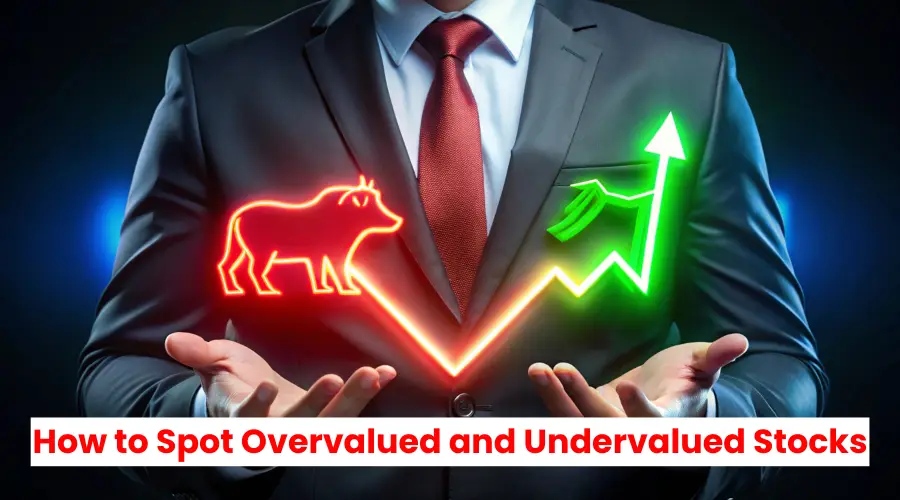Stock Market
How to Spot Overvalued and Undervalued Stocks
Stock market mein paisa kamana sab chahte hai… but how many really know what they’re buying is worth it?
It’s easy to get excited about trending stocks and ignore their actual value. But if you're someone who seriously wants to grow wealth in the long run — understanding whether a stock is overvalued or undervalued is a must-have skill. And don’t worry, it’s not rocket science — even beginners can get it with the right mindset and some practice.
Let’s decode this today in a way that’s not just bookish but real world.
What Does Stock Valuation Actually Mean?
Basic idea of stock valuation
When you value a stock, you're basically asking: "Is the current price fair for what I’m getting?"
You’re buying a slice of a business. So you must know, is it worth ₹100 or is it really worth ₹60, but hyped to ₹100?
Why knowing the value matters for your money
Buying overpriced stocks = risking capital for small returns or even losses.
Buying underpriced stocks = opportunity to earn more when market corrects itself.
Understanding Overvalued Stocks
What "Overvalued" actually looks like
Overvalued stocks are those trading at higher prices than what their financial performance justifies.
For example, if a small-cap company with no profits is trading at 80x earnings just because of hype, red flag!
Common signs of overvaluation
- Very high P/E or PEG ratios
- Stock price rising without earnings growth
- Everyone on YouTube or social media is hyping it (danger zone)
- Sudden 50–100% rise in a short time with no news
Why overvalued stocks can be risky
They usually crash hard when the bubble bursts.
Retail investors who enter late often get stuck at the top 😓
Understanding Undervalued Stocks
What makes a stock "undervalued"
Undervalued stocks are trading below their intrinsic worth. This could be because of temporary bad news, ignored sector, or just low awareness.
Key indicators of undervalued opportunities
- Low P/E compared to sector average
- High dividend yield
- Good fundamentals but poor recent sentiment
- Cash-rich company trading at low Price-to-Book ratio
Famous undervalued examples from Indian market
-
ITC (2019–21):
Ignored by market, but had solid cash flows and dividends. Gave massive breakout later.
-
HDFC AMC during 2022–23:
Low valuation due to short-term underperformance, then rebounded strong.
Popular Valuation Metrics That Help You Spot the Truth
Price-to-Earnings (P/E) Ratio
-
Low P/E =
possibly undervalued (but check the reason)
-
High P/E =
possibly overvalued (unless justified by growth)
Price-to-Book (P/B) Ratio
Especially useful in banking and NBFC stocks.
If P/B < 1 = market may be underestimating the value of assets.
PEG Ratio
-
PEG =
PE ÷ Earnings Growth
-
PEG < 1 =
undervalued
-
PEG > 1.5 =
maybe overvalued
Dividend Yield
High dividend yield with strong fundamentals = underpriced stock.
But high yield + poor financials = dividend trap!
Earnings per Share (EPS) Growth
Stable or rising EPS over 3–5 years is a good indicator of actual value.
What Market Sentiment Tells You (and Doesn’t Tell You)
Emotional investing vs value investing
Don’t get carried away with:
- Market euphoria (FOMO)
- Meme stock trends
- YouTube “10x stock in 2 months” types
Herd mentality and how it affects prices
If everyone’s buying blindly, price will rise — but not always for the right reasons.
Train yourself to think like a smart investor, not a crowd follower.
Real Indian Examples: Overhyped vs Hidden Gems
A stock that looked shiny but wasn’t
Yes Bank (2018–2020) — People kept buying on dips thinking it’s cheap.
In reality, fundamentals were crashing. Stock fell from ₹300+ to ₹10.
A boring stock that quietly gave 5x returns
Relaxo Footwear — Ignored by market for years. Focused on consistent profit growth. Delivered massive returns for patient investors.
Red Flags to Avoid When Spotting Value
- Sudden jump in promoter pledging
- Aggressive accounting (too many adjustments)
- Unrealistic growth promises
- Low volume or illiquid stocks
- Fancy buzzwords without actual results (“AI", “Blockchain”, “Fintech” overload)
Conclusion:
Spotting overvalued and undervalued stocks is not about finding the next Tesla. It’s about staying grounded and using real data instead of hype.
You don’t need to be a CA or analyst, you just need the right training strategy and practice.
And if you’re serious about learning this skill from real market experts (not influencers), start with a trusted course from the best share market institute in pune, where you'll learn how to read stocks like a business, not just price charts.
Because in the stock market, value matters more than vibes.
Disclaimer:
This blog is for educational purposes only and should not be considered as financial advice or stock recommendations. Always consult a certified financial advisor or do your own research before making investment decisions. Stock markets are subject to risks — past performance is not a guarantee of future returns.
FAQs:
Q1: Can a stock be undervalued forever?
Yes. Sometimes the market ignores good companies for long. But when awareness or results catch up, revaluation happens.
Q2: Should I only buy undervalued stocks?
Not necessarily. Some growth stocks are expensive but still worth it due to high future earnings. Balance is key.
Q3: What if I invest in an overvalued stock by mistake?
Use stop-loss. And learn to analyze better next time. Losses are teachers too.
Q4: Is undervalued always safe?
Not always. Sometimes stocks are cheap for a reason, like fraud, poor management, etc. Do full homework.




